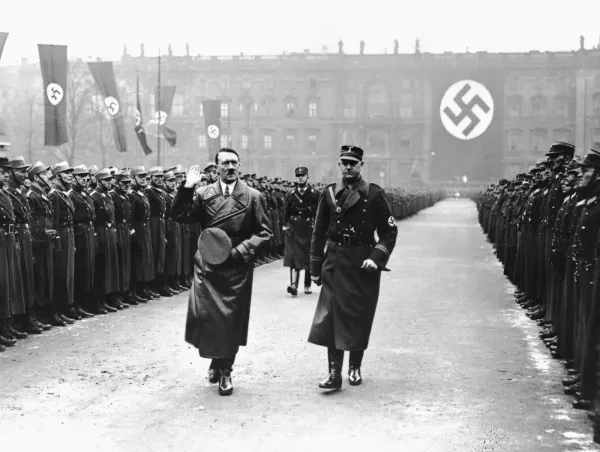
World War II was one of the bloodiest wars ever fought that lasted 6 years. Starting with Hitler’s invasion of Poland in 1939 and ending with the allied defeat of Nazi Germany and Japan, the war claimed one of the highest military and civilian casualties amounting to more than 50 million deaths (with estimates as high as 85 million deaths). The war was also marked by the Holocaust and the atomic bombing of Hiroshima and Nagasaki. World War II set the stage for the rise of the Superpowers, USA and Russia. Regarded as the most wide spread and bloodiest wars, here is a look at the 10 most important World War 2 Battles.
10. Invasion of Poland
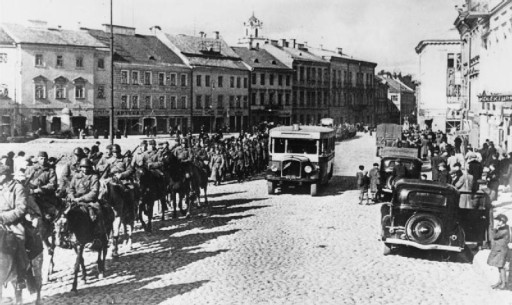
Also known as the ‘September Campaign’ or the ‘Poland Campaign’, was a joint invasion of Poland by Nazi Germany and the Soviet Union. Beginning on 1st September 1939 with the German invasion followed by the Soviet invasion on 17 September, the campaign ended on 6 October with Poland being divided between Nazi Germany and the Soviet Union. This campaign marked the beginning of World War II and therefore features on this list. This battle also marked the entry of Britain and France into the War, when both countries declared war on Germany for invading Poland, although they did little to actually supply any troops to help Poland. Another reason this battle was featured on this list is because the Hitler, wary of the Soviets coming to the aid of Poland, signed a non-aggression pact with them. The German army had some 2,400 tanks organized into six panzer divisions, which would be followed up by less-mobile mechanized infantry and foot soldiers. The Luftwaffe (Air force) provided airpower, particularly the ‘dive-bombers’. The Polish relied on their Calvary brigade, foot soldiers and their air force. The Soviets relied on their infantry, tanks and air force. However, in the end, Poland did not have the numerical advantage of the Axis Powers, despite their brave defense. The Germans and Soviets, along with a small Slovak army had a total strength of over 2 million, and the Polish, could barely round up 1 million in the surprise of the attack to ward off the invasion. The Axis armies suffered 59,000 casualties, while the Polish army suffered close to 800,000 casualties. At the end of the campaign, Poland was divided between Germany and the Soviet Union.
9. Battle of Sedan
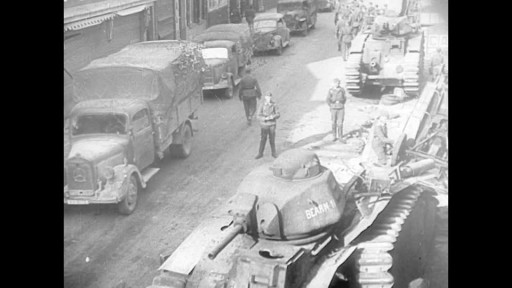
Also known as the Second Battle of Sedan (the First being the Franco – Prussian War of 1870), was fought in 1940 during the French campaign. Fought by Nazi Germany and the armies of France and Britain, this Battle was instrumental in the fall of France and also expelled the British army from the continent. The French, after their defeat in World War 1, took into account geography, resources and manpower, and strategized the construction a heavy concrete fortifications known as the Maginot Line, to protect themselves from a possible future German attack. They considered the Maginot line to be impenetrable, impervious to air attack and would slow down the German attack force, allowing France to resupply and also defend France from a possible sneak attack by the German’s from the Belgium border. However, the French had ignored the possibility of a German attack through Ardennes–Sedan sector, as the the French were certain such terrain could not be crossed by tanks. Those expectations where shattered in May 1940 when the Germans launched a fast-paced "Blitzkreig" spearheaded by Panzer tanks, through the Ardennes Forest. The Germans could muster, in total, 60,000 men, 22,000 vehicles, 771 tanks, 141 artillery pieces and 1470 aircrafts of the Luftwaffe. The French could only muster 20,000 men, 300 tanks, 174 artillery pieces, 152 bombers and 250 aircrafts. The attack happened so fast, that there were hardly any major combats. The Battle of Sedan also led to the bulk of the retreat of British soldiers who were trapped in the port of Dunkirk. The Germans won the ensuing Battle of Dunkirk. There is no known estimate of lives lost because of the speed of the attack; many French soldiers were in such shock that they were taken prisoner before they could offer resistance, which also explains the low casualty rates for both sides.
8. Battle of Britain
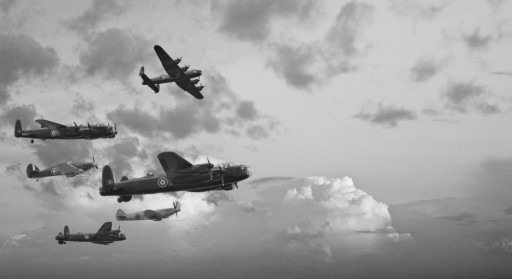
The Battle of Britain was fought between the British Royal Air Force and The German Luftwaffe. After the fall of France, Winston Churchill declared "The Battle of France is over. I expect the Battle of Britain is about to begin." Britain possessed an effective air defense system, first-rate fighter pilots, and a great military leader in Air Marshal Hugh Dowding. The Germans on the other hand were unprepared because of the heavy loss incurred by the Luftwaffe in the West. Even more serious, the Germans had poor intelligence and little idea of British vulnerabilities. The Luftwaffe's Messerschmitt Bf 109E and Bf 110C fought against the RAF's workhorse Hurricane Mk I and the less numerous Spitfire Mk I; Hurricanes outnumbered Spitfires in RAF Fighter Command by about 2:1. The Royal Air force had about 1,963 serviceable aircraft, and the Axis power comprising of the Germans and Italians had about 2,550 serviceable aircraft. The losses incurred by the British were 544 aircrew (RAF Fighter Command), 718 (RAF Bomber Command), 280 (RAF Coastal Command) killed, 422 aircrew wounded and 1,744 aircraft destroyed. The Axis power sustained a loss of 2,585 aircrew killed and missing, 925 captured, 735 wounded, 1,977 aircraft destroyed, 1,634 in combat and 343 non-combat. The Battle was decisive in proving that superior air defense was enough to win a major war and resulted in Hitler postponing the Invasion of Britain.
7. Battle of the Atlantic
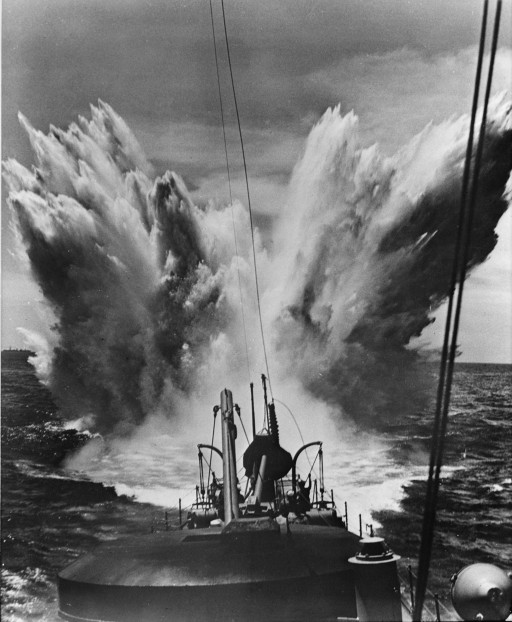
The longest continuous military campaign of World War 2, starting in 1939 and ending with Germany’s defeat in 1945. This battle pitted the Allied power (comprising of USA, Britain, France, Poland, Norway) against the Axis Powers (comprising of Germany and Italy). The battle came down to technology superiority. The objective was blockade of the Axis powers in Europe and security of Allied sea movement. The Battle involved thousands of ships in more than 100 convoy battles and perhaps 1,000 single-ship encounters, in a theatre covering millions of square miles of ocean. The situation changed constantly, with one side or the other gaining advantage, as participating countries surrendered, joined, and even changed sides in the war, and as new weapons, tactics, counter-measures, and equipment were developed by both sides. During World War II, U-boat warfare was the major component of the Battle of the Atlantic, and the Germans had the largest submarine fleet in World War II hence one of the pre-requisites for pushing back the Axis was the defeat of the U-boat threat.This battle saw a great number of casualties on both sides. The Allied forces lost 3,500 merchant vessels, 175 warships, 741 RAF Coastal Command Aircraft lost in anti-submarine sorties and close to 60,000 sailors and merchant seamen. The Germans lost 783 U-boats and 30,000 sailors, while the Italians lost 500 sailors and 17 submarines. The outcome of the battle was a strategic victory for the Allies.
6. Battle of Iwo Jima
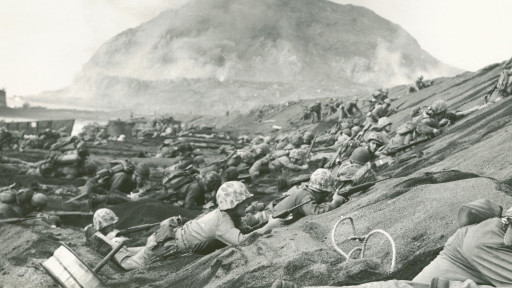
Fought between the United States and Japan and lasting almost 5 weeks (19 February 1945 - 26 March 1945), this operation was designated ‘Operation Detachment’ by the Americans. Following elaborate preparatory air and naval bombardment, three U.S. marine divisions landed on the island in February 1945. Iwo Jima was defended by roughly 23,000 Japanese army and navy troops, who fought from an elaborate network of caves, dugouts, tunnels and underground installations. The strength of the US army included 110,000 U.S. Marines, U.S. Soldiers, U.S. Navy corpsmen, USAAF personnel, and others including over 500 ships. While the Japanese comprised of 20,530–21,060 troops, 23 tanks, 438 artillery pieces, 33 naval guns, 69 anti-tank guns and almost 300 anti-aircraft guns. One of the most important weapons used by the Americans and found to be effective against the Japanese was the M2 flamethrower. This battle was amongst the fiercest and bloody battles of World War 2. Both sides incurred many casualties, the American casualties numbered 6,821 killed, 19,217 wounded and 2 captured but recovered; while the Japanese casualties included 17,845–18,375 dead and missing, 216 taken prisoner and almost 3000 in hiding. However after the heavy losses incurred in the battle, the strategic value of the island became controversial.
5. Battle of El Alamein

There were two battles at El Alamein, Egypt, fought between the Axis powers (Nazi Germany and Italy) and the Allied powers. The Battle of El Alamein was primarily fought between two of the outstanding commanders of World war two, Lieutenant-General Montgomery, and the German General Rommel (Rommels’s nickname was the ‘Desert Fox’ given to him by the British). The Reason this battle, in the desert of North Africa was pivotal, was because if the Afrika Korps got to the Suez Canal, the ability of the Allies to supply themselves would be severely dented. The only alternate supply route would be via South Africa – which was not only longer but a lot more dangerous due to the uncertainty of the weather. The loss of this war would have demoralised the Allied forces, especially as this would have given Germany near enough free access to the oil in the Middle East. El Alamein was a last stand for the Allies in North Africa. El Alamein was a bottleneck that ensures that Rommel could not use his favoured form of attack – sweeping into the enemy from the rear. The Allies had more than 200,000 men and more than 1000 tanks. Including the 300 Sherman tanks, with their 75 mm gun shot a 6lb shell that could penetrate a Panzer at 2000 metres. To cope with Montgomery’s attack, the Germans had 110,000 men and 500 tanks. A number of these tanks were poor Italian tanks and could not match the new Sherman’s. The Germans were also short of fuel. By November 2nd 1942, Rommel knew that he was beaten. Hitler ordered the Afrika Korps to fight to the last but Rommel refused to carry out this order. On November 4th, Rommel started his retreat. 25,000 Germans and Italians had been killed or wounded in the battle and 13,000 Allied troops in the Eighth Army.
4. Battle of Leyte Gulf
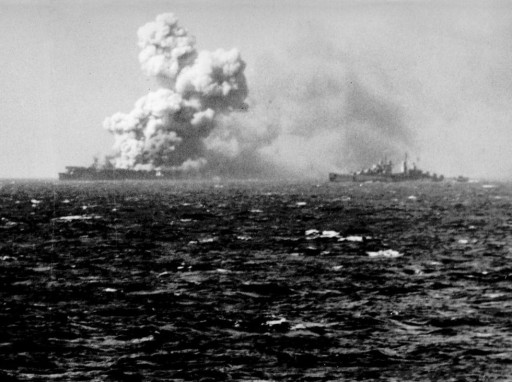
Generally considered to be the largest naval battle of World War 2 and possibly the largest naval battle in history. It was fought in waters near the Philippine islands of Leyte, Samar and Luzon, from 23–26 October 1944, between combined American and Australian against the Imperial Japanese Navy. The battle consisted of four separate engagements between the opposing forces, and it was also the first time the famous ‘Kamikaze attacks’ were used by Japanese pilots – wherein the Japanese pilots would crash their aircrafts into the Allied ships to produce devastating damage than a conventional attack. The strength of the allied forces were phenomenal and consisted of 300 ships in total; 8 fleet carriers, 8 light carriers,18 escort carriers, 12 battleships,24 cruisers,166 destroyers and destroyer escorts, many PT boats, submarines, and fleet auxiliaries and almost 1,500 planes. The Japanese forces numbered 67+ ships in total; 1 fleet carrier, 3 light carriers,9 battleships,14 heavy cruisers,6 light cruisers,35+ destroyers and almost 300 planes. The Allied forces suffered around 3000 casualties and 200 destroyed planes, whereas the Japanese suffered almost 12500 casualties and 300 planes destroyed. The battle crippled the Japanese Combined Fleet, permitted U.S. invasion of the Philippines, and reinforced the Allies’ control of the Pacific.
3. Operation Barbossa

This was the code name for the Axis invasion (comprising of Nazi Germany, Finland, Italy, Croatia, Hungary, Romania and Slovakia) of the Soviet Union, that happened on June 22, 1941, some 4.5 million troops launched a surprise attack. Although both sides signed a non-aggression pact they were both suspicious of each other, but that pact only gave the Germans time to prepare for the invasion. The Soviets were so unprepared for the attack that within one week of the invasion, German forces advanced 200 miles into Soviet territory, destroyed nearly 4,000 aircraft, and killed, captured, or wounded some 600,000 Red Army troops. By December of 1941, German troops were within sight of Moscow. But the Germans were unprepared for Russian winter (nicknamed “General Winter”) and Hitler’s plan to conquer Russia before winter had failed. This proved to be turning point in the war when the Red Army fought back and put a halt to the already frozen German army. Although some of the following figures are open to debate, the Axis powers faced total military casualties amounting to over 1 million while the Soviets numbers amounted to over 4 million. This battle was considered to be on the most adventurous and deadliest battles of World War II, where the Germans, with their surprise attack initially had the upper hand, but with the onset of winter and a ‘new’ Red Army, faced certain defeat.
2. Invasion of Normandy

Also called Operation Overlord, during World War II, the Allied invasion of Western Europe, which was launched on June 6, 1944 with the simultaneous landing of U.S., British, and Canadian forces on five separate beachheads in Normandy, France. The Normandy invasion began with overnight parachute and glider landings, massive air attacks and naval bombardments. The following morning, the Allied forces landed on multiple beaches to launch a ground attack. The sheer scale of this operation is unfathomable, with a 1,200-plane airborne assault preceded an amphibious assault involving more than 5,000 vessels. Nearly 160,000 troops crossed the English Channel on 6 June, and more than two million Allied troops were in France by the end of August whereas the strength of the German army was about 380,000. The casualties encountered by July numbered around 120,000 for the Allied armies and 110,000 for the German army. By the end of August 1944 all of northern France was liberated, and the invading forces reorganized for the drive into Germany, where they would eventually meet with Soviet forces advancing from the east to bring an end to the Nazi Reich.
1. Battle of Stalingrad (23 August 1942 – 2 February 1943)
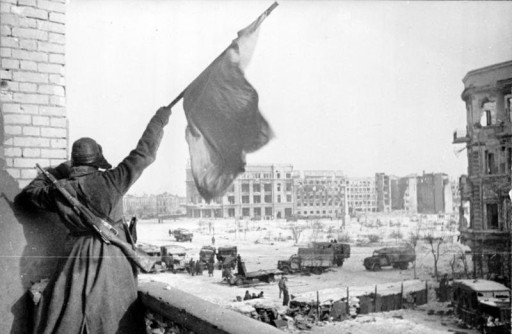
This was a major battle of World War II in which Nazi Germany and its allies fought the Soviet Union for control of the city of Stalingrad (now Volgograd) in Southern Russia. The invading Germans saw the conquest of Stalingrad as essential to their campaign in southern Russia, since from this strategic point on the Volga River they could launch further assaults in the Caucasus. In addition, seizing the city that bore the name of the Soviet dictator Joseph Stalin would serve as a great propaganda tool for Adolf Hitler. This battle is considered one of the bloodiest and fiercest and was marked by a lot of close quarter combat between the Soviet and German soldiers. The Germans had never witnessed this urban warfare and dubbed it “Rattenkrieg” meaning Rat war - for both sides, Stalingrad became a desperate ordeal of rodent like scurrying from hole to hole. In the initial phase of the attack the German armies strength numbered as follows; 270,000 personnel, 3,000 artillery pieces, 500 tanks and 600 aircraft- which increased to 1600 by mid-September. The Soviets numbered 187,000 personnel, 2,200 artillery pieces, 400 tanks and 300 aircraft. At the time of the Soviet counter-offensive the number of soldiers from the Axis force increased to over 1 million men, 10,250 artillery pieces, 500 tanks and 732 aircrafts. At the same time, the Soviet forces also increased their numbers to over 1.14 million men, nearly 13,000 artillery pieces, 894 tanks and over 1100 aircrafts. The casualties and losses on both sides were large, the Germans lost over 750000 men, 900 aircraft, 1500 tanks and 6000 guns; whereas the Soviet army casualties numbered over 1 million men either killed, missing or wounded, over 2700 aircraft, over 4000 tanks and 15000 guns. The Battle of Stalingrad was one of the bloodiest battles in history, with combined military and civilian casualties of nearly 2 million. At one point during the battle, the Soviets realized that they were under tremendous constraints of time and resources and ordered that anyone strong enough to hold a rifle be sent to fight. This battle marked the certain end of the German Reich, and turned the tides of the war.
This is our take on the Top 10 most important battles of World War 2; if some of these battles never happened there never would have been a World War; but the others happened only to bring back peace in a very uncertain time. Hope you’ve enjoyed the read and do let us know what you think.
